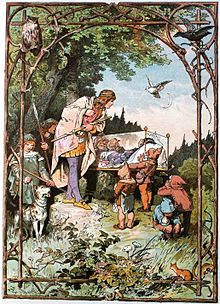| Snow White | |
|---|---|
 Schneewittchen by Alexander Zick | |
| Folk tale | |
| Name | Snow White |
| Aarne–Thompson grouping | 709 |
| Country | Germany |
"Snow White" is a German fairy tale, first written down in the early 19th century. The Brothers Grimm published it in 1812 in the first edition of their collection Grimms' Fairy Tales, numbered as Tale 53. The original German title was Sneewittchen; the modern spelling is Schneewittchen. The Grimms completed their final revision of the story in 1854, which can be found in the 1857 version of Grimms' Fairy Tales.[1][2]
The fairy tale features elements such as the magic mirror, the poisoned apple, the glass coffin, and the characters of the Evil Queen and the seven Dwarfs. The seven dwarfs were first given individual names in the 1912 Broadway play Snow White and the Seven Dwarfs and then given different names in Walt Disney's 1937 film Snow White and the Seven Dwarfs. The Grimm story, which is commonly referred to as "Snow White",[3] should not be confused with the story of "Snow-White and Rose-Red" (in German "Schneeweißchen und Rosenrot"), another fairy tale collected by the Brothers Grimm.
In the Aarne–Thompson folklore classification, tales of this kind are grouped together as type 709, Snow White. Others of this kind include "Bella Venezia", "Myrsina", "Nourie Hadig", "Gold-Tree and Silver-Tree",[4] "The Young Slave", and "La petite Toute-Belle".
- ^ Cite error: The named reference
multiple2was invoked but never defined (see the help page). - ^ Jacob Grimm; Wilhelm Grimm (2014-10-19). The Original Folk and Fairy Tales of the Brothers Grimm: The Complete First ... Princeton University Press. ISBN 978-1-4008-5189-8. Retrieved 2016-04-05.
- ^ Cite error: The named reference
bartelswas invoked but never defined (see the help page). - ^ Cite error: The named reference
surlawas invoked but never defined (see the help page).